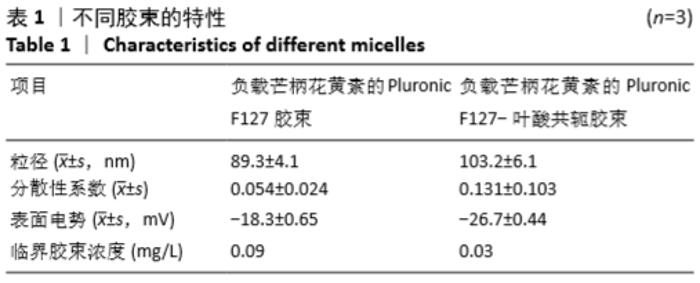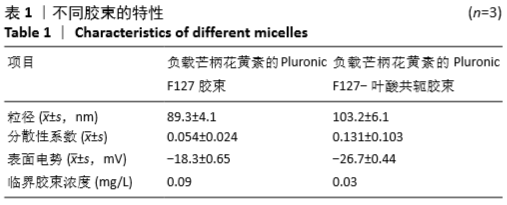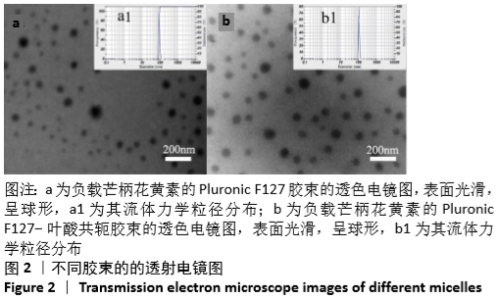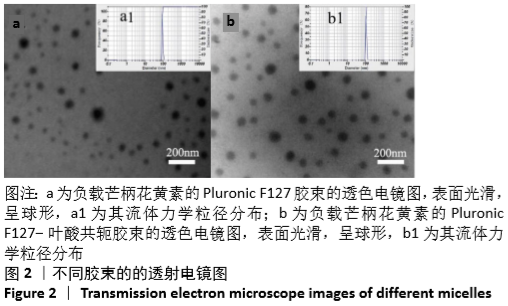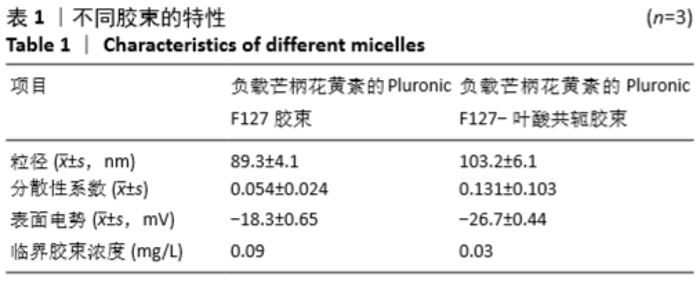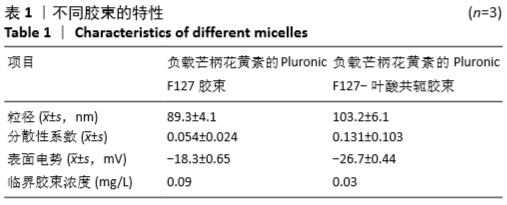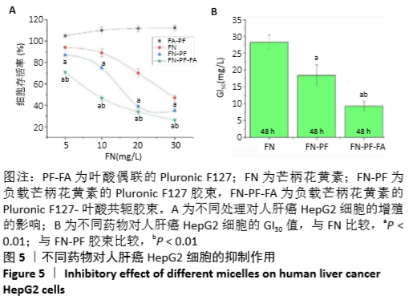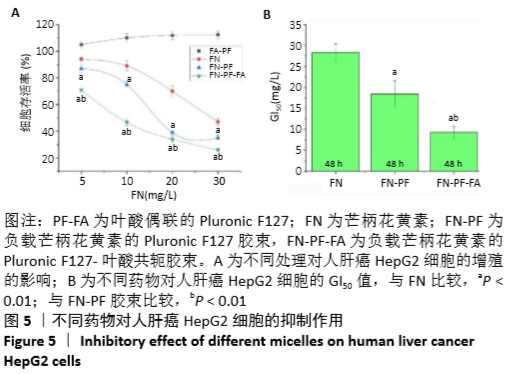Chinese Journal of Tissue Engineering Research ›› 2021, Vol. 25 ›› Issue (4): 526-531.doi: 10.3969/j.issn.2095-4344.2364
Previous Articles Next Articles
Anti-hepatoma activity of targeted Pluronic F127/formononetin nanocomposite system in vitro
Liu Yang, Gong Yi, Fan Wei
- Second Department of Hepatobiliary Surgery, Guizhou Provincial People’s Hospital, Guiyang 550002, Guizhou Province, China
-
Received:2019-12-05Revised:2019-12-11Accepted:2020-02-22Online:2021-02-08Published:2020-11-21 -
Contact:Fan Wei, MD, Chief physician, Second Department of Hepatobiliary Surgery, Guizhou Provincial People’s Hospital, Guiyang 550002, Guizhou Province, China -
About author:Liu Yang, Master, Chief physician, Second Department of Hepatobiliary Surgery, Guizhou Provincial People’s Hospital, Guiyang 550002, Guizhou Province, China -
Supported by:the Science and Technology Program of Guiyang in 2016, No. 20161001
CLC Number:
Cite this article
Liu Yang, Gong Yi, Fan Wei. Anti-hepatoma activity of targeted Pluronic F127/formononetin nanocomposite system in vitro[J]. Chinese Journal of Tissue Engineering Research, 2021, 25(4): 526-531.
share this article
Add to citation manager EndNote|Reference Manager|ProCite|BibTeX|RefWorks
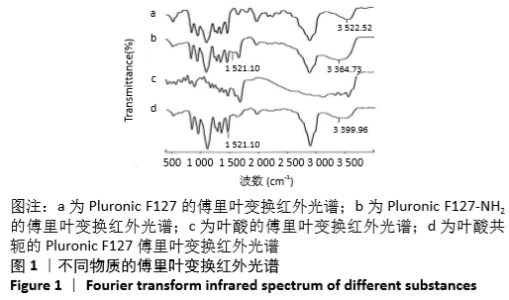
2.1 PF-FA共轭傅里叶变换红外光谱的表征 PF、PF-NH2、叶酸和PF-FA的傅里叶变换红外光谱如图1所示。PF在 3 522.5 cm-1处出现典型的羟基峰,而PF-NH2在3 364, 1 521 cm-1处出现新的吸收峰,分别对应于胺基(N-H,宽)和羰基(C=O)峰[19]。在叶酸中,3 600-3 000 cm-1出现羟基(-OH)和N-H拉伸振动峰,羧基的C=O拉伸振动出现在 1 692 cm-1处,1 640 cm-1处出现峰值,这与-CO-NH基团的C=O键拉伸振动有关;1 605 cm-1处为N-H振动的弯曲模态,1 412 cm-1处为苯基骨架的-OH变形带,苯环的特征吸收峰出现在1 483 cm-1。在PF-FA中,3 399 cm-1(N-H)和1 521 cm-1 (C=O)处出现的吸收峰与PF-FA结构中的酰胺基(-CO-NH)有关。"
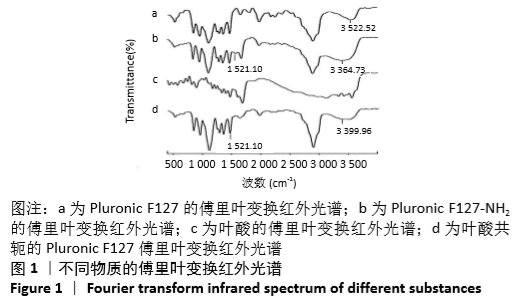
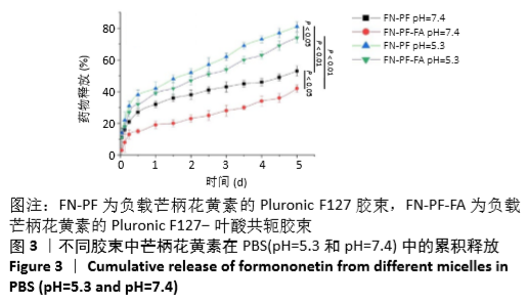
2.4 芒柄花黄素的包封率和体外释放 FN-PF和FN-PF-FA胶束的包封率分别为(84.12±2.15)%和(82.50±1.78)%,两种胶束具有很高的包封率,这可能是由于PF分子的非极性基团很大,形成了一个与FN相互作用的强疏水核,允许更多的包封。FN-PF和FN-PF-FA胶束的载药量分别为(21.33±2.27)%和(19.73±1.58)%。 两种胶束释放的芒柄花黄素如图3所示,在最初的 12 h(30%-40%)内观察到一次突释,随后进入缓释期,在相同pH值下,FN-PF-FA胶束释放芒柄花黄素的速率慢于FN-PF;同一胶束不同pH值下,pH=5.3时约80%的芒柄花黄素在5 d内释放,而同期只有约50%的芒柄花黄素在pH=7.4下释放(P < 0.01),这可能是由于在酸性pH值下芒柄花黄素的分散性较高[21]。"
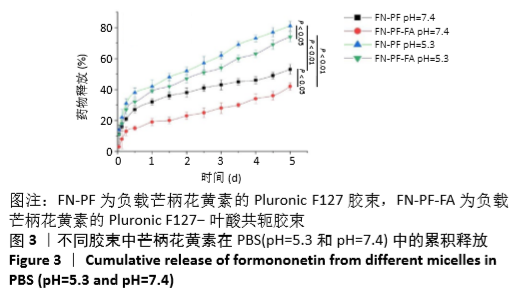
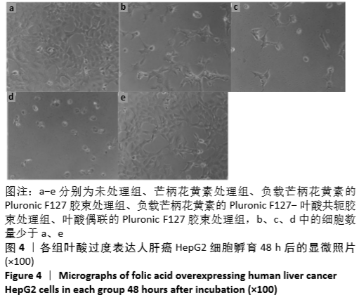
2.5 体外抗癌实验结果 相对于空白对照组和对照组,芒柄花黄素组、FN-PF组、FN-PF-FA组的细胞数量减少,其中FN-PF-FA组细胞均呈现圆形,几乎无细胞贴壁生长,见图4。用GI50值来量化芒柄花黄素在PF-FA胶束制剂50%孵化细胞在设计时间段内的生长[22]。从图5A可以看出相对于芒柄花黄素,在相同浓度下FN-PF和FN-PF-FA胶束对HepG2细胞的抑制作用显著提高(P < 0.05);相同浓度下与FN-PF胶束对比,FN-PF-FA胶束对HepG2细胞抑制作用显著提高(P < 0.05)。 芒柄花黄素的GI50为(28.6±1.2) mg/L,FN-PF胶束的GI50大幅度降低至(17.4±0.78) mg/L,即降低了38.46%;FN-PF-FA胶束的GI50值为(9.5±0.4) mg/L,即与芒柄花黄素相比减少66.43%,与FN-PF胶束相比减少44.83%(P < 0.01),见图5B。"
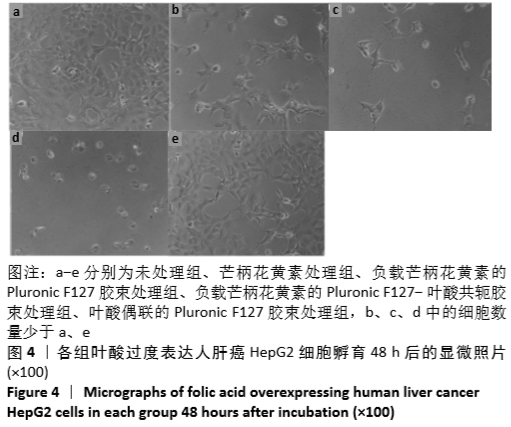
| [1] HU Y, RAN J, ZHENG Z, et al. Exogenous stromal derived factor-1 releasing silk scaffold combined with intra-articular injection of progenitor cells promotes bone-ligament-bone regeneration. Acta Biomater.2018;71:168-183. [2] MANSOORI MN, TYAGI AM, SHUKLA P, et al. Methoxyisoflavones formononetin and isoformononetin inhibit the differentiation of Th17 cells and B-cell lymphopoesis to promote osteogenesis in estrogen-deficient bone loss conditions.Menopause.2016;23(5):565-576. [3] LI L, XU J, MA Y, et al. Local Upregulation of Stromal Cell–Derived Factor-1 After Ligament Injuries Enhances Homing Rate of Bone Marrow Stromal Cells in Rats.Tissue Eng Part A.2009;15(8):2277-2284. [4] WANG XH, SUN ZG, LUO L, et al. Formononetin promotes apoptosis of colorectal cancer cells via activation of mitochondria-dependent MAPK pathway. Trop J Pharm Res.2019;18(2):243-249. [5] FERREIRA FM, CASTRO RA, BATISTA MA, et al. Association of water extract of green propolis and liposomal meglumine antimoniate in the treatment of experimental visceral leishmaniasis. Parasitol Res. 2014;113(2):533-543. [6] LIU J, YONG H, YAO X, et al. Recent advances in phenolic–protein conjugates: synthesis, characterization, biological activities and potential applications.RSC Adv.2019;9 (61):35825-35840. [7] PRAKASH I, JETTI R, TAN C, et al. Steviol Glycoside Sweeteners with Improved Flavor Profiles. U.S. Patent Application No.15/765,095. [8] DAVIS JJ, COLEMAN KS, AZAMIAN BR, et al. Chemical and biochemical sensing with modified single walled carbon nanotubes.Chem Eur J. 2003;9(16):3732-3739. [9] CAPEK I. Degradation of kinetically-stable o/w emulsions. Adv Colloid Interface Sci.2004;2107(2-3):125-155. [10] PAWAR A, PATEL R, ARULMOZHI S, et al. D-α-Tocopheryl polyethylene glycol 1000 succinate conjugated folic acid nanomicelles: towards enhanced bioavailability, stability, safety, prolonged drug release and synergized anticancer effect of plumbagin.RSC Adv.2016;6(81): 78106-78121. [11] HU H, YU J, LI Y, et al. Engineering of a novel pluronic F127/graphene nanohybrid for pH responsive drug delivery.J Biomed Mater Res A. 2012;100(1):141-148. [12] YASIR M, SARA U S, CHAUHAN I, et al. Solid lipid nanoparticles for nose to brain delivery of donepezil: formulation, optimization by Box–Behnken design, in vitro and in vivo evaluation. Artif Cells Nanomed Biotechnol. 2018;46(8):1838-1851. [13] RAJPOOT K, JAIN SK. Colorectal cancer-targeted delivery of oxaliplatin via folic acid-grafted solid lipid nanoparticles: preparation, optimization, and in vitro evaluation.Artif Cells Nanomed Biotechnol. 2018;46(6):1236-1247. [14] LOW PS, HENNE WA, DOORNEWEERD DD. Discovery and development of folic-acid-based receptor targeting for imaging and therapy of cancer and inflammatory diseases.Acc Chem Res. 2007;41(1):120-129. [15] HAO J, TONG T, JIN K, et al. Folic acid-functionalized drug delivery platform of resveratrol based on Pluronic 127/D-α-tocopheryl polyethylene glycol 1000 succinate mixed micelles.Int J Nanomed. 2017;12:2279-2292. [16] ZHANG RY, WANG ZY, YANG XQ, et al. Folic acid modified Pluronic F127 coating Ag2S quantum dot for photoacoustic imaging of tumor cell-targeting.Nanotechnol.2018;29(5):055101. [17] GRIMAUDO MA, PESCINA S, PADULA C, et al. Poloxamer 407/TPGS mixed micelles as promising carriers for cyclosporine ocular delivery.Mol Pharm.2018;15(2):571-584. [18] CHENG XL, ZHOU TY, LI B, et al. Methotrexate and 5-aminoimidazole-4-carboxamide riboside exert synergistic anticancer action against human breast cancer and hepatocellular carcinoma.Acta Pharm Sin B.2013;34(7):951. [19] KWAK M, MUSSER AJ, LEE J, et al. DNA-functionalised blend micelles: mix and fix polymeric hybrid nanostructures.Chem Commun. 2010; 46(27):4935-4937. [20] MOHAPATRA S, MALLICK SK, MAITI TK, et al. Synthesis of highly stable folic acid conjugated magnetite nanoparticles for targeting cancer cells.Nanotechnol.2007;18(38):385102. [21] TAY KC, TAN LTH, CHAN CK, et al. Formononetin: A review of its anticancer potentials and mechanisms.Front Pharmacol.2019.DOI: 10.3389/fphar.2019.00820 [22] PATIL S, CHOUDHARY B, RATHORE A, et al. Enhanced oral bioavailability and anticancer activity of novel curcumin loaded mixed micelles in human lung cancer cells.Phytomedicine.2015;22(12):1103-1111. [23] DRBOHLAVOVA J, CHOMOUCKA J, ADAM V, et al. Nanocarriers for anticancer drugs-new trends in nanomedicine.Curr Drug Metab. 2013:14(5):547-564. [24] VIDYA PRIYADARSINI R, NAGINI S. Cancer chemoprevention by dietary phytochemicals: promises and pitfalls.Curr Pharm Biotechnol. 2012;13(1):125-136. [25] UN E, HAVA AM. A near-state PWM method with reduced switching losses and reduced common-mode voltage for three-phase voltage source inverters. IEEE Trans Ind Appl.2009;45(2):782-793. [26] SUTHIWANGCHAROEN N, NAGARAJAN R. Controlled design and construction of multifunctional nanoparticles by molecular self-assembly. RSC Adv.2014;4(20):10076-10089. [27] SONG X, GAN K, QIN S, et al. Preparation and characterization of general-purpose gelatin-based co-loading flavonoids nano-core structure. Sci Rep.2019;9(1):1-11. [28] ZHAO X, LIU P. Reduction-responsive core–shell–corona micelles based on triblock copolymers: novel synthetic strategy, characterization, and application as a tumor microenvironment-responsive drug delivery system.ACS Appl Mater Inter.2014;7(1):166-174. [29] PINDIPROLU SKS, KRISHNAMURTHY PT, CHINTAMANENI PK, et al. Nanocarrier based approaches for targeting breast cancer stem cells.Artif Cells Nanomed Biotechnol.2018;46(5):885-898. |
| [1] | Liu Cong, Liu Su. Molecular mechanism of miR-17-5p regulation of hypoxia inducible factor-1α mediated adipocyte differentiation and angiogenesis [J]. Chinese Journal of Tissue Engineering Research, 2021, 25(7): 1069-1074. |
| [2] | He Xiangzhong, Chen Haiyun, Liu Jun, Lü Yang, Pan Jianke, Yang Wenbin, He Jingwen, Huang Junhan. Platelet-rich plasma combined with microfracture versus microfracture in the treatment of knee cartilage lesions: a meta-analysis [J]. Chinese Journal of Tissue Engineering Research, 2021, 25(6): 964-969. |
| [3] | Li Wenjing, Li Haobo, Liu Congna, Cheng Dongmei, Chen Huizhen, Zhang Zhiyong. Comparison of different bioactive scaffolds in the treatment of regenerative pulp of young permanent teeth [J]. Chinese Journal of Tissue Engineering Research, 2021, 25(4): 499-503. |
| [4] | Chen Junyi, Wang Ning, Peng Chengfei, Zhu Lunjing, Duan Jiangtao, Wang Ye, Bei Chaoyong. Decalcified bone matrix and lentivirus-mediated silencing of P75 neurotrophin receptor transfected bone marrow mesenchymal stem cells to construct tissue-engineered bone [J]. Chinese Journal of Tissue Engineering Research, 2021, 25(4): 510-515. |
| [5] | Sun Qi, Zhou Yanan, Dong Xin, Li Ning, Yan Jiazhen, Shi Haojiang, Xu Sheng, Zhang Biao. Metal-ceramic interface characteristics of Co-Cr alloy fabricated by selective laser melting [J]. Chinese Journal of Tissue Engineering Research, 2021, 25(4): 521-525. |
| [6] | Zhou Jihui, Yao Meng, Wang Yansong, Li Xinzhi, Zhou You, Huang Wei, Chen Wenyao. Influence of novel nanoscaffolds on biological behaviors of neural stem cells and the related gene expression [J]. Chinese Journal of Tissue Engineering Research, 2021, 25(4): 532-536. |
| [7] | Liu Jiangfeng. Nano-hydroxyapatite/polyamide 66 composite filling combined with locking plate in the treatment of fibrous dysplasia of femoral bone [J]. Chinese Journal of Tissue Engineering Research, 2021, 25(4): 542-547. |
| [8] | Li Quanxi, Shen Yu, Wan Wei, Sun Shanzhi. Changes of abdominal wall mechanics and pain after tension-free inguinal hernia repair with polypropylene mesh [J]. Chinese Journal of Tissue Engineering Research, 2021, 25(4): 548-552. |
| [9] | Li Xingping, Xiao Dongqin, Zhao Qiao, Chen Shuo, Bai Yiguang, Liu Kang, Feng Gang, Duan Ke. Preparation and properties of copper-loaded antibacterial functional film on titanium surface [J]. Chinese Journal of Tissue Engineering Research, 2021, 25(4): 553-557. |
| [10] | Li Li, Ma Li. Immobilization of lactase on magnetic chitosan microspheres and its effect on enzymatic properties [J]. Chinese Journal of Tissue Engineering Research, 2021, 25(4): 576-581. |
| [11] | Chang Wenliao, Zhao Jie, Sun Xiaoliang, Wang Kun, Wu Guofeng, Zhou Jian, Li Shuxiang, Sun Han. Material selection, theoretical design and biomimetic function of artificial periosteum [J]. Chinese Journal of Tissue Engineering Research, 2021, 25(4): 600-606. |
| [12] | Liu Fei, Cui Yutao, Liu He. Advantages and problems of local antibiotic delivery system in the treatment of osteomyelitis [J]. Chinese Journal of Tissue Engineering Research, 2021, 25(4): 614-620. |
| [13] | Liu Keke, Duan Xin, Ma Xiangrui, Zhang Yuntao. Effect of cinnamaldehyde on osteoblasts in high glucose environment with the electrospinning membrane as a carrier [J]. Chinese Journal of Tissue Engineering Research, 2021, 25(22): 3500-3504. |
| [14] | Wang Shengjun, Yin Fei, Jiang Maoyu. Application of titanium ossicular prosthesis in one-stage open tympanoplasty for middle ear cholesteatoma [J]. Chinese Journal of Tissue Engineering Research, 2021, 25(22): 3505-3509. |
| [15] | Liu Chang, Li Datong, Liu Yuan, Kong Lingbo, Guo Rui, Yang Lixue, Hao Dingjun, He Baorong. Poor efficacy after vertebral augmentation surgery of acute symptomatic thoracolumbar osteoporotic compression fracture: relationship with bone cement, bone mineral density, and adjacent fractures [J]. Chinese Journal of Tissue Engineering Research, 2021, 25(22): 3510-3516. |
| Viewed | ||||||
|
Full text |
|
|||||
|
Abstract |
|
|||||
